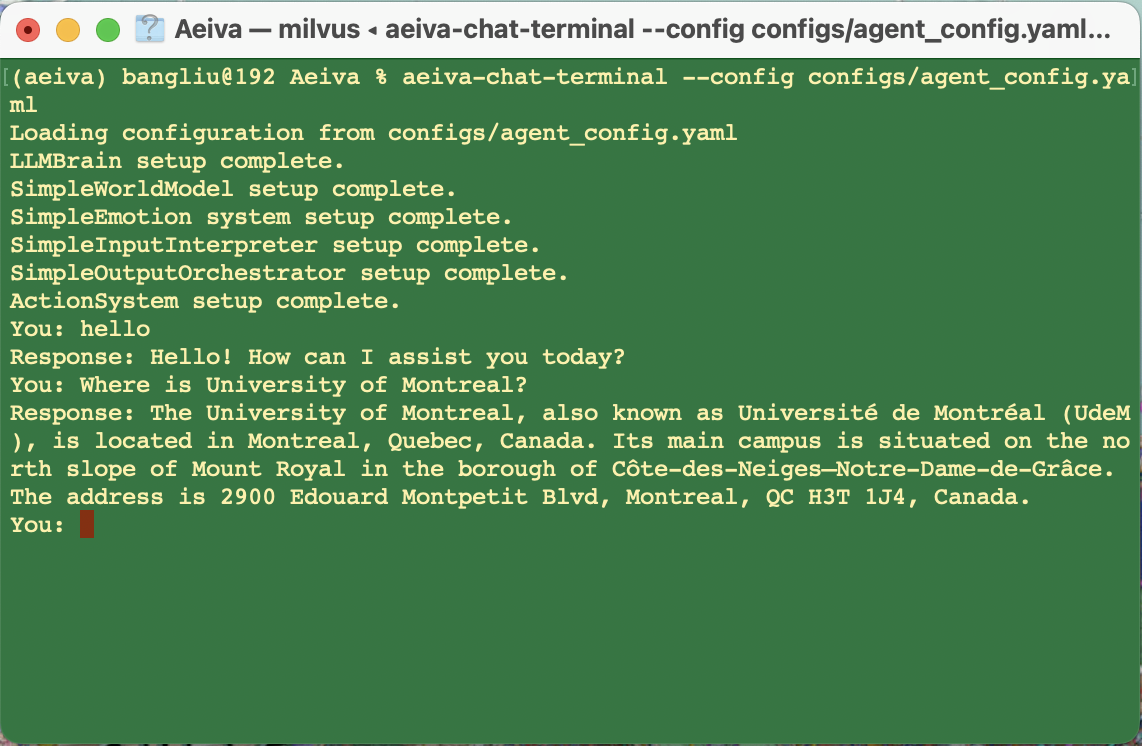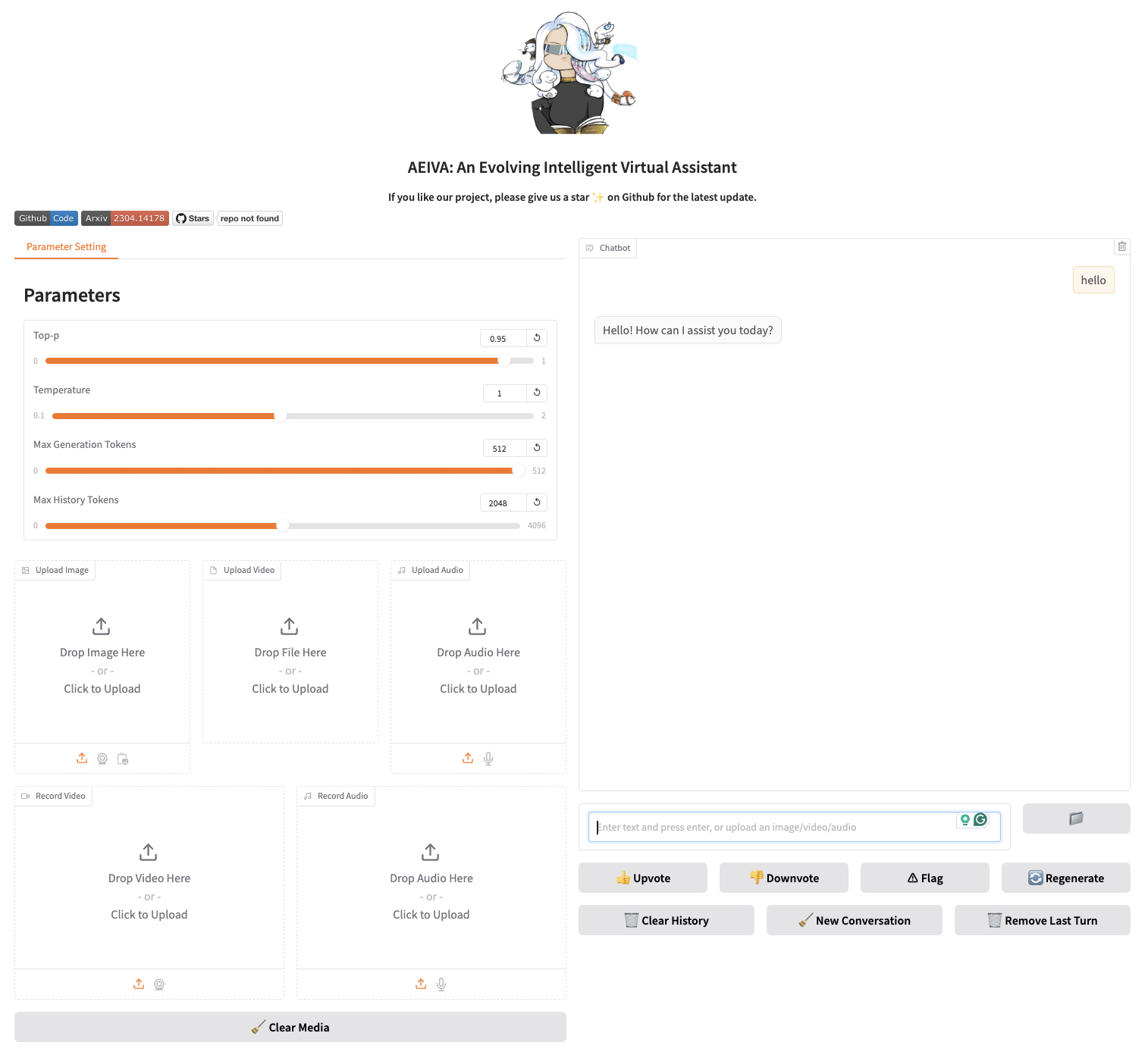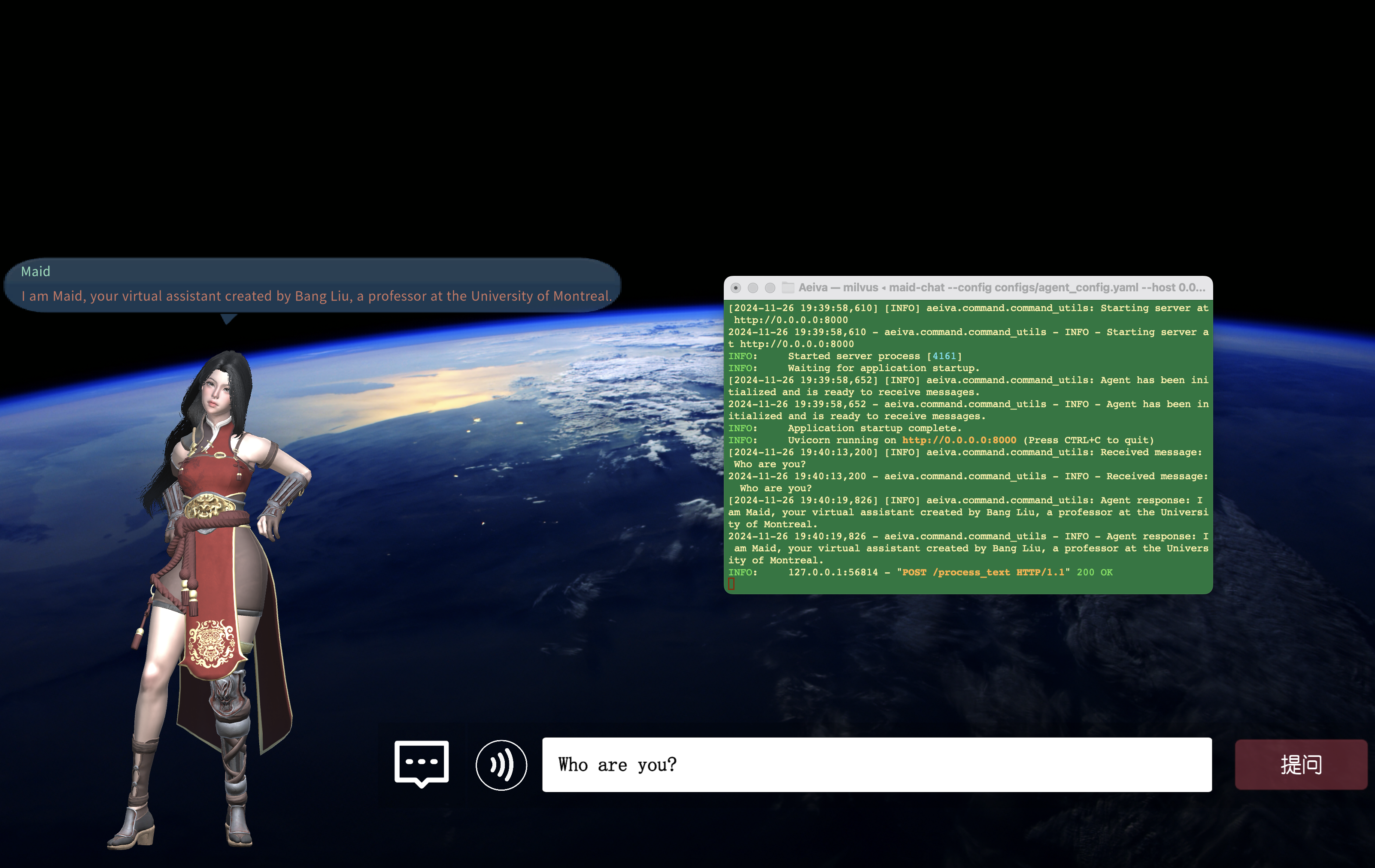In this project, our objective is to develop a modular and flexible intelligent agent and society system, designed as a virtual assistant capable of performing diverse tasks, learning from data, environment, and interactions, and self-evolving over time. The system will leverage deep learning models, primarily transformers, while also exploring innovative models and learning methods.
Our ultimate goal is to develop a General AI Agent System capable of forming a “genius society” of AI agents. These agents will:
- Collaboratively address and solve societal challenges across domains.
- Function in diverse environments, from virtual simulations to real-world applications.
- Continuously evolve and improve through self-assessment and adaptation.
- Serve as versatile assistants in various roles, such as AI researchers, software engineers, game players, or digital society members.
Currently, Aeiva supports the following interaction modes:
- Chat in terminal: chat with an agent in the terminal interface
- Chat with Gradio Webui: we developed a gradio web UI interface that allows user to chat with the agent. We plan to support multimodality in the near future.
- Chat with desktop Waifu mode: by combining with our another project
Maid, we can use our agent as the backend and call it through Maid desktop assistant.
⭐️ Documentation 👉 aeiva documentation
Currently, we features with the following functionalities:
- Rich Toolkits: I have implemented a series of different API tools and I'm keep improving the API library.
- Open Operator: By implementing computer-use related tools, aeiva is able to understand and operate user's computer and complete daily tasks. We are keep enhancing the functionality in this part. Note: use this feature with caution!
- Memory Palace: I have designed and implemented a layered memory palace for storaging agent memories. It is flexible and can be customized to represent and query different types of memories.
More functionalities and modules will be implemented gradually. Keep tuned! If you find any errors or bugs, feel free to report by opening an issue, thanks a lot!
To install AEIVA, follow these steps:
Python 3.10or newerpip(Python package manager)
You can easily install vai pip by:
pip install aeiva-
Clone the AEIVA Repository
First, clone the AEIVA repository to your local machine using Git:
git clone https://github.com/chatsci/Aeiva.git cd Aeiva -
Create a Virtual Environment (Recommended) It's a good practice to create a virtual environment for Python projects. This keeps dependencies required by different projects separate. Use the following command to create a virtual environment with
conda:conda create --name <my-env>
Replace
<my-env>with the name of your environment.To acivate your env:
conda activate <my-env>
For more advanced configurations or options, please check the online document of
conda. -
Install Dependencies Install all dependencies listed in requirements.txt:
pip install -r requirements.txt
-
Install Aeiva Finally, install AEIVA using the setup.py script:
python setup.py install
-
Verify Installation To verify that AEIVA has been installed correctly, you can run the following command:
python -c "import aeiva; print(aeiva.__version__)"
Our memory module utilizes different types of databases.
-
Vector Database: Our memory module also utilizes vector database. Please install vector database such as
milvus(recommended),chroma,qdrant, orweaviate. -
Graph Database: Ensure Neo4j is installed and the
NEO4J_HOMEenvironment variable is set. -
Relational Database: We use
sqlite(recommended) orpostgre sql.
After installing Neo4j and setting the environment variable, follow these steps to run different aeiva chat commands.
Run the following command in terminal:
aeiva-chat-terminal --config configs/agent_config.yaml --verbose-
Options:
--configor-c: Path to the configuration file (default:configs/agent_config.yaml).--verboseor-v: Enable verbose logging for detailed output.
-
Using the Interface:
- Interact with the chatbot directly in your terminal after running the command. * View Logs:
- Logs are stored at
~/.aeiva/logs/aeiva-chat-terminal.log. - To monitor logs in real-time, use:
tail -f ~/.aeiva/logs/aeiva-chat-terminal.log
You will see your terminal is like below:
Run the following command in terminal:
aeiva-chat-gradio --config configs/agent_config.yaml --verbose-
Options:
--configor-c: Path to the configuration file (default:configs/agent_config.yaml).--verboseor-v: Enable verbose logging for detailed output.
-
Access the Gradio Interface:
- Open your web browser and navigate to http://localhost:7860.
- Alternatively, use the public URL provided in the terminal output (e.g., https://1b1f89328e57b2f2e1.gradio.live) to access the interface remotely.
-
View Logs:
- Logs are stored at
~/.aeiva/logs/aeiva-chat-gradio.log. - To monitor logs in real-time, use:
tail -f ~/.aeiva/logs/aeiva-chat-gradio.log
- Logs are stored at
By visiting the gradio interface, you will see a gradio web-ui like below:
Run the following command in terminal:
aeiva-server --config configs/agent_config.yaml --host 0.0.0.0 --port 8000 --verbose- Options:
--configor-c: Path to the configuration file (default: configs/agent_config.yaml).--hostor-H: Host address to run the server on (default: 0.0.0.0).--portor-p: Port number to run the server on (default: 8000).--verboseor-v: Enable verbose logging for detailed output.
- Access the Server:
- Open your web browser and navigate to
http://localhost:8000/docsto access the interactive API documentation.
- Open your web browser and navigate to
- View Logs:
- Logs are stored at
~/.aeiva/logs/aeiva-server.log. - To monitor logs in real-time, use:
tail -f ~/.aeiva/logs/aeiva-server.log
- Logs are stored at
Run the following command in terminal to get an animated virtual assisatnt on your deskto that you can talk in voice mode or by typing:
maid-chat --config configs/agent_config.yaml --host 0.0.0.0 --port 8000 --verbose-
Options:
--configor-c: Path to the configuration file (default:configs/agent_config.yaml).--hostor-H: Host address to run the server on (default:0.0.0.0).--portor-p: Port number to run the server on (default:8000).--verboseor-v: Enable verbose logging for detailed output.
-
Download
Maid.app:- Download
Maid.appfrom here.
- Download
-
Set
MAID_HOMEEnvironment Variable:- Unix/Linux/macOS:
export MAID_HOME='/path/to/my/unity.app/Contents/MacOS/Maid - Your Intelligent Waifu !' source ~/.bashrc # or source ~/.zshrc
- Windows (Command Prompt):
set MAID_HOME=C:\path\to\my\unity\app
- Windows (PowerShell):
Replace
$env:MAID_HOME = "C:\path\to\my\unity\app"
/path/to/my/unity/apporC:\path\to\my\unity\appwith the actual path to your Unity application.
- Unix/Linux/macOS:
-
Using the Interface:
- Interact with the server through the Maid.app Unity application after running the command.
-
View Logs:
- Logs are stored at
~/.aeiva/logs/maid-chat.log. - To monitor logs in real-time, use:
tail -f ~/.aeiva/logs/maid-chat.log - Logs are stored at
-
Troubleshooting:
-
Permission Denied Error When Starting Unity Application: If you encounter an error like:
Error: Failed to start Unity application: [Errno 13] Permission denied: '/path/to/my/unity/app'Solution:
-
macOS Users:
- Open System Preferences.
- Navigate to Security & Privacy.
- Click on the Privacy tab.
- Select Accessibility from the sidebar.
- Click the lock icon to make changes and enter your password.
- Click the "+" button and add your terminal application (e.g., Terminal, iTerm).
- Ensure that your terminal application is checked, granting it the necessary permissions to run the Unity application.
-
Windows Users:
- Right-click on the Unity application executable.
- Select Properties.
- Go to the Compatibility tab.
- Check Run this program as an administrator.
- Click Apply, then OK.
- Try running the command again.
Ensure that the
MAID_HOMEenvironment variable points to the correct path of your Unity application. -
-
Demo of Maid-chat:
To cite Aeiva in publications, please use the following BibTeX entries.
@misc{bang2024aeiva,
title={Aeiva: An Evolving Intelligent Virtual Assistant},
author={Bang Liu},
year={2024},
url={https://github.com/chatsci/Aeiva}
}






